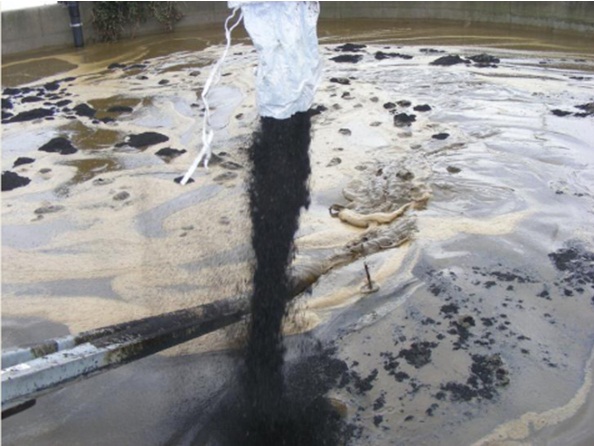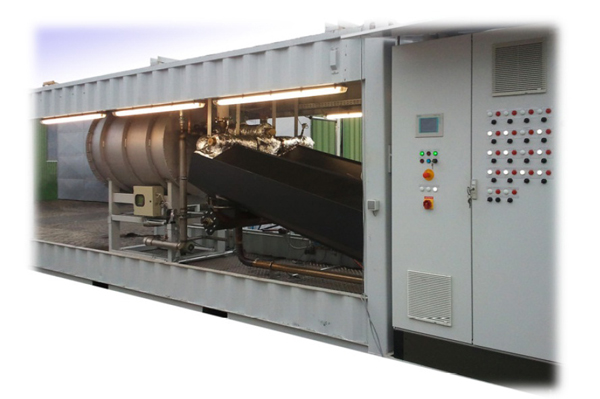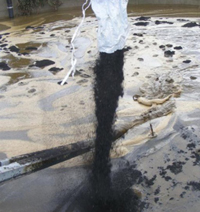Carbon as a raw material and as a limiting factor for sustainable economic development
Both industry and the ecosystem have a huge appetite for carbon. Yet while industry gains its carbon through plundering the earth’s fossil resources built up over millions of years, only to burn it or convert it into plastic, all living things rely on the natural carbon cycle to provide them with valuable energy and cell-building material.
Put simply, the carbon cycle involves plants, algae and certain specialised types of bacteria adsorbing CO2 from the atmosphere and using the sun’s energy to synthesise it into the carbon molecules used in cell growth. Once this has been done, the complex organic carbon molecules become food for microorganisms and animals. Their digestion processes in turn splits up the complex molecules, releasing the solar energy stored in them for their own use. This process ends with the carbon molecules being broken down into their smallest stable units and returned to the atmosphere in the form of CO2 or CH4, thereby restarting the cycle.
The natural role of carbon is thus to supply energy and nutrients. It is also a battery for storing solar energy, a framework for all natural substances, a mobile storage device for nutrients and a hard drive for genetic information. Carbon is the key element in all life processes!
In nature the carbon cycle described above is basically intact. Just think: each carbon molecule in our bodies has at some stage in the Earth’s history been CO2 in the atmosphere, sugar or an amino-acid in a plant, protein in meat and humus in the soil.
Restoring the carbon cycle
To achieve truly sustainable economic development in tune with nature, industry needs to become an integral part of the carbon cycle described above. The target must be for industry to only use carbon taken from the natural carbon cycle and to return it there after use. If on the other hand we go on burning fossil coal, oil and gas, all of it extracted millions of years ago from the biosphere, the natural carbon cycle will stay imbalanced, causing climate change and the destruction of natural habitats.
The key to restoring the carbon cycle is using and recycling biomass. Biomass must be recognised as the most important raw material for our civilisation and a new economy.
Biomass: the one and only renewable raw material
Subject to permanent natural recycling, biomass is the one and only truly renewable raw material. Throughout the world, biomass assimilates some 120 gigatonnes of carbon from the atmosphere each year. The same amount is returned to the atmosphere through respiration, decay and natural fire. On top of this, some 9 gigatonnes of carbon are entered into the cycle from fossil sources through human activity. To re-balance the cycle, these 9 gigatonnes need to be taken from renewable sources.
If just 7.5% of the carbon stored each year in biomass were to be taken away from natural respiration and decay and given over to industrial use in the form of stable carbon, the natural carbon cycle could be re-balanced and the 9 gigatonnes of fossil carbon replaced. The amount of carbon gained from biomass each year would have to be the absolute maximum used by industry.
Replacing fossil carbon through biomass recycling
Mankind’s hope for the future is dependent on fossil carbon being replaced by biomass carbon. The use of wood as a building material is one of the oldest examples of removing the carbon found in biomass from the carbon cycle for a few hundred years and then returning it to the cycle through burning it or letting it rot. Up to now, building wood and compost were the only ways of stabilising the carbon found in biomass for interim use, removing it from the carbon cycle for a certain period of time. The development of new technologies and their combination are now making this possible for all forms of biomass.
Biomass can be fermented to produce methane gas, whereby the solid residue, rich in lignin, can be used to produce plastic for use in such things as computers or car components (see for example www.tecnaro.de). Liquid residue can be used as a fertiliser. Instead of just letting biomass rot, it should be used as a source of energy and as a raw material. Fuel produced through biomass fermentation has no adverse effect on the climate, and the organic building materials act as a medium-term carbon sink until they are composted at the end of their product life.
A further exceedingly promising technology for the intelligent use of the natural carbon cycle is pyrolysis. Through heating any form of biomass in the near absence of oxygen, high caloric gas and recalcitrant biochar are produced. Using pyrolysis, some 65% of the carbon originally contained in the biomass can be concentrated and stabilised in the form of biochar. Dependent on the type of biomass used, biochar is made up of 50 – 90% carbon. Hardly degradable by microbial action, it can be removed from the carbon cycle for several centuries and be used as a soil additive or a building material.
Biochar in agriculture
Used for thousands of years for producing organic soil substrates, feed supplements and for the conservation of organic fertilisers, biochar (in its charcoal form) disappeared from the scene with the onset of industrial agriculture. The old techniques were forgotten. It is only in the last ten years that the possibilities offered by biochar have been rediscovered. A whole new research sector has developed over the last few years, dedicated to the production, characterisation and application of biochar. At the same time, a new industrial sector is emerging, focused on transforming biochar into new high-value industrial products. Though still “early days”, the sector has already come up with an impressive range of products, enabling the carbon found in biomass to be used more efficiently.
The cascading use of biochar
As in the natural carbon cycle, biochar in agriculture is mainly used as a carrier and groundmass for making more efficient use of natural nutrient cycles. This can be impressively seen in the cascading use of biochar in livestock farming and fertiliser management, in both of which particular use is made of biochar’s high adsorption capacity.
- Mixing biochar at 1% by volume to silage prevents the formation of mycotoxins, binds pesticides and suppresses the formation of butyric acid, meaning that fermentation can take place in a perfectly clean manner, thereby improving feed quality.
- Via the silage, the biochar finds its way into animal feed, improving animal digestion, increasing roughage and reducing GHG production.
- Mixing biochar at 10% by volume into litter is a way of binding liquid nutrients and reducing ammonia emissions. It helps prevent putrefaction, thus improving hygiene in the stables. Just two days after applying biochar, a noticeable change in how the stables smell can be registered.
- Regularly mixed into slurry at 1 – 5% by volume, biochar binds volatile nutrients and improves the microbial environment. This leads to less nutrients being lost, thereby improving the slurry’s fertilising effect and reducing phyto-toxicity and GHG emissions.
- After filtering out the liquids, the slurry’s solids are composted together with the stable litter, ultimately yielding valuable black earth due to the high biochar content.
- Through working the biochar-rich black earth and the stabilised liquid slurry into the soil, the soil’s propensity to retain water is heightened and infiltration and aeration improved, resulting in increased microbial activity and thus higher yields. Soil acidification is prevented, and fertilisers and pesticides leach into groundwater at a much lower rate.
- Enriched with organic nutrients, the biochar thus finds its way into farmland soil, where it is hardly degraded by microbes and thus constitutes a valuable carbon sink. This is even more effective when biochar acts as a groundmass for organic molecules, thereby promoting the creation of humus.
For more information on the use of biochar in livestock farming, see the Ithaka articles: Treating liquid manure with biochar and Biochar in Poultry Farming.

Treating slurry with biochar on the Holderstock farm. (Photo: Wilhelmine and Bruno Koller)
Marketable biochar-based agricultural products
Beside the cascading use of biochar described above, there are further interesting uses for biochar in agriculture that have already been taken up by the market:
- as a compost supplement for greater nutrient efficiency and lower GHG emissions
- as a binder for use in dry toilets (local production of “terra preta”)
- as a carbon fertiliser in association with mineral or organic plant nutrients to reduce fertiliser leaching and to improve nutrient efficiency
- as a long-term fertiliser in association with such organic residues as wool, bristles, feathers, helping to activate nutrients in hitherto unused biomasses
- as carbon feed, improving digestion
- in fish breeding for improving water quality.
What has now turned out to be counterproductive (contrary to previous recommendations) is the application of large quantities of untreated and non-loaded biochar to the soil. The main use of biochar is as a carrier and binder for organic nutrients. As such it needs to be specifically applied. Its successful use in agriculture is dependent on it being strategically integrated into organic material cycles. On its own, biochar is nothing but a skeleton without flesh.
The use of biochar in industry
There are also promising uses of biochar in areas other than agriculture. For instance, biochar can be used for insulating homes, as a reducing agent in metallurgy, as a storage medium in batteries, as a raw material for carbon fibres and plastics, or as a water or air filter. The first industrial applications are already in use, with one of the main fields being home insulation open to diffusion.
Technology for producing biochar
The greatest bottleneck preventing the large-scale use of the different forms of biochar is the production technology. The optimistic forecasts made two years ago that within two years there would be over 50 plants operating in Germany and Switzerland have unfortunately not materialised. Due to the heterogeneity of the biomasses used and the sustained very high temperatures needed in the reactors, the various manufacturers are still fighting teething problems. Despite these setbacks the technology has nevertheless made great progress over the last two years. The company Pyreg is now operating 5 plants in Switzerland, Germany and Austria, each with an annual biochar output of 300 tonnes. Carbon Terra is using its own technology to produce 1000 tonnes of biochar a year. Looking just at Europe, the two German companies, Rewenergy and BioMaCon, and the Danish BlackCarbon have each developed their own pyrolysis plants and will soon be bringing them to market. There is reason to hope that 2013 will become the year in which pyrolysis technology achieves its breakthrough.

Pyreg was the first company to develop certified biochar production plants. These are the only plants currently operating at independent producers.
Quality control – biochar certification
On account of the wide range of biochar applications and the different forms of production technology, quality control is of crucial importance, whether with regard to product quality or the environmental impact of its production. This is the reason why the European Biochar Foundation has developed the European Biochar Certificate (EBC). Biochar producers throughout Europe can now have their products certified by an independent QA agency. In Switzerland, the EBC is used by the Federal Agricultural Agency as the basis for the provisional approval of biochar. The Agency is also expected to decide on full approval for the use of biochar as a soil additive and as a recycling fertiliser in the beginning of 2013. Biochar already has official approval for use as a feed supplement, both in Switzerland and in Europe.
Manufacturers of industrial pyrolysis equipment
Pyreg GmbH: Pyrolysis plants with an annual biochar production capacity of 300 tonnes: www.pyreg.de
Carbon Terra GmbH: Pyrolysis plants with an annual biochar production capacity of 1000 tonnes: www.carbon-terra.de
Regenis GmbH: Pyrolysis plants with an annual biochar production capacity of 500 tonnes: www.rewenergy.de
Biomacon GmbH: Various pyrolysis plants, with production capacities ranging from 140 to 2000 tonnes: www.biomacon.com
BlackCarbon: Pyrolysis plants with combined electricity production and annual biochar production capacity of 300 tonnes: www.blackcarbon.dk
European Companies selling biochar:
Germany: EM-Chiemgau, CarbonTerra, BioMaCon,
Switzerland: Swiss Biochar (EBC-certified)
Austria: Sonnenerde (EBC-certified)



- Please write us your comment -
×